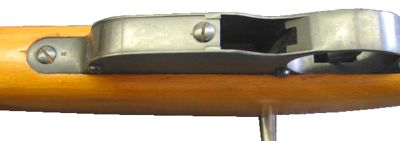
Steyr Mannlicher 8x56R M95/30 short rifle (upgraded and shortened M95), left side.
Image: Frank Rodyns, Belgium

same 8x56R Steyr Mannlicher M95/30 short rifle, right side, with the loaded en bloc clip shown in front of the gun.
Image: Frank Rodyns, Belgium

Steyr Mannlicher M95/30 rifle, with bolt open and loaded clip partially inserted into action; note how the bolt handle remains horizontal, as opposed to more common rotating bolt actions such as Mauser.
Image: Frank Rodyns, Belgium

Drawing of the Mannlicher 1895 straight-pull bolt system; note the curved ribs and cuts marked with the dotted lines, which rotate the bolt head on bolt open/close action.

Bottom view on the Steyr Mannlicher M95 rifle, showing the large opening, through which the empty clip is ejected.
| M95 long rifle | M95/30 rifle | |
| Caliber | 8x50R М93 | 8x56R M30 |
| Overall length | 1272 mm | 1000 mm |
| Barrel length | 765 mm | 480 mm |
| Weight | 3,8 kg empty | 3,36 kg empty |
| Magazine capacity | 5 rounds in en bloc clip | 5 rounds in en bloc clip |
The Steyr M1895 rifle, also known as Steyr-Mannlicher M95 straight pull rifle, was developed by famous Austrian arms designer Ferdinand Ritter Von Mannlicher. Based on his previous M1890 design, this rifle was manufactured in Austro-Hungarian Empire at state arms factories in Steyr (Austria) and Budapest (Hungary). More than 3 millions of M95 rifles were produced between 1895 and 1918. This rifle was issued to Austro-Hungarian army, and, after the fall of the Empire, to the Austrian and Hungarian armies. Originally produced in 8x50R caliber, in 1924 some of M95 rifles were converted to the German 7.92x57 Mauser (also known as 8x57 Mauser) ammunition. These converted rifles featured shorter 58 cm barrels, were designated as M95/24 and used in Yugoslavia and Bulgaria. This conversion gave away with original Mannlicher en bloc clip, and replaced it with Mauser stripper clips. Since 1930 Austria converted most of the M95 rifles to the more powerful 8x56R M30 ammunition, using the same Mannlicher en bloc clips. These rifles were designated as M95/30, and marked with the letter "S" on the receiver ring. Hungary started to convert their rifles to the same 8x56R ammunition in 1931, with the upgraded rifles being marked with the letter "H" on the receiver ring. Many of the M95 rifles were used during the Word War 2 by the Hungarian, Bulgarian and Italian armies, as well as by some German police forces.
Ferdinand Von Mannlicher developed his first straight-pull bolt action rifle by 1884, and by 1885 he developed the famous Mannlicher en block clip, which was inserted into the box magazine from the top, and automatically ejected through the opening at the bottom of the magazine as the last round was chambered. This significantly speed up the loading process, compared to the earlier designs with magazines loaded by single rounds; the problem was that such magazine could not be loaded with loose rounds without the clip. As a result, during the early part of the 20 century Mannlicher en bloc clip was generally replaced by the Mauser-type stripper clip. Earliest Mannlicher straight-pull rifles have had not so strong wedge-locking system, but in 1890 he introduced a straight pull bolt action with rotary bolt head with two lugs, which he latter used in M95 rifles.
Steyr Mannlicher M95 bolt has a separate head with two frontal locking lugs; bolt head was inserted into the bolt body from the front. Bolt body had internal spiral-shaped ribs, with matching spiral-shaped cuts in the tail of the bolt head. These ribs and cuts forced the bolt head to rotate on the pull of the bolt body, locking and unlocking the action. Box magazine contained five rounds in en bloc clips; as the magazine emptied, the clips were ejected from the opening at the bottom of the magazine. Non-empty clips could be removed from the top with the bolt open, by depressing the clip catch inside the triggerguard. One specific feature of this system was that the clip has specific "top" and "bottom" sides, and could not be loaded into the rifle upside down. The safety was located at the rear left side of the bolt. Large ear-shaped cocking handle at the rear of the bolt served as a manual cocking handle, to re-cock the action without operating the bolt. M95 rifles were issued with detachable knife bayonets. Other than basic rifle, M95 also was issued as Stutzen (short rifle or carbine, with bayonet lug), and slightly shorter cavalry carbine (without bayonet lug).
These rifles are generally considered as a reasonably strong and accurate, but somewhat sensitive to mud and dirt, as most others military straight pull bolt action rifles. There were several downsides, inherent to these rifles. The straight pull bolt lacked the powerful initial extraction, provided by most rotating bolt actions. Large opening at the bottom of the magazine easily collected the dirt and dust into the magazine. The en block clip loading system does not allow the partially full magazine to be refilled without removing the non-empty clip first. The use of rimmed ammunition resulted in the non-symmetric clip which could be inserted into the action only with one side down; upper side of the clip has stamped serrations to hold it while loading (this particular problem was cured in Italian Carcano rifles, which used rimless ammunition, and symmetric clips).

Tidak ada komentar:
Posting Komentar